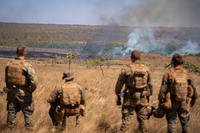SCHRIEVER AIR FORCE BASE, Colo. -- The Air Force launched four GPS satellites into orbit this year, the highest number of GPS launches since 1993. But as the Air Force quickly upgrades its most recognizable space constellation, a little known group of Airmen works tirelessly behind the scenes.
Between the time a satellite is launched and the 50th Space Wing receives satellite control authority for it, a small team is busy testing and evaluating, ensuring that each spacecraft is ready to begin its job of providing position, navigation, and timing to more than 3 billion worldwide users.
As part of the 2 SOPS Mission Analysis Flight, these analysts work through a complex launch and early-orbit process, all while maintaining each of the other 38 satellites in the GPS constellation.
"It can be a stressful time," said 1st Lt. Robert Heffner, 2 SOPS chief of GPS subsystems analysis shop. "If there is a lag on anyone's part, it can set the whole launch timeline off, which means more work for everyone."
Their work often begins more than 60 days out from launch.
Heffner, who concentrates on the GPS vehicle or "bus," first sets up links with the satellite as it sits on the ground at Cape Canaveral, Florida.
"We start with compatibility tests," he said. "Our teammates at the Cape plug it into our monitor-station network. We put the vehicle in a known configuration, upload software and then ensure its components are functioning properly. This is our last chance to test before launch. We don't want any surprises when it's actually on orbit."
As Heffner evaluates the vehicle, Capt. Aaron Blain, 2 SOPS chief of GPS navigation payload analysis shop, focuses on the spacecraft's payload - it's position, navigation, and timing components. Like Heffner, he's testing and ensuring functionality.
Much of the action occurs while the satellite is still waiting to be lifted on to a launch platform at the Cape.
Following the launch, their work kicks into an even higher gear.
Once the vehicle reaches its proper orbit, 2nd Lt. Christopher Phillips, 2 SOPS chief of NDS analysis and tactics shop, begins testing and evaluating the secondary payload that resides on every GPS vehicle: the Nuclear Detonation Detection System.
Though GPS is perhaps the most recognizable satellite constellation in the world, it's safe to say most people don't know that each of its satellites carries an NDS payload.
"NDS performs an important mission," Phillips said. "It helps verify the Limited Test Ban Treaty of 1963. It makes sense. The whole reason the GPS constellation has these nuclear detonation sensors is because it provides global coverage. We can see every part of the planet."
While Phillips tests the satellite's NDS components, Heffner and Blain perform a second round of evaluations.
"We have to make sure the telemetry, tracking and control system works, so that we can command the vehicle. That's our first concern," Heffner said. "This occurs the same day as the launch, while the vehicle is in sun safe mode and still spinning."
Meanwhile, Heffner performs a ground-antenna evaluation, loads programs and commands, and evaluates the vehicle's computer processor and electrical power system. Then he switches individual components on.
"We evaluate everything just like we did on the ground," he said. "Because...things behave differently in space."
Blain's first job once the vehicle reaches orbit, is to determine its exact location. He uses a variety of ground antennas to narrow down, then determine the precise orbit trajectory of the satellite. Once complete, he begins turning on payload components as well.
"When we turn on the payload antennas, the vehicle heats up," he said. "We do that partly to cook off all the excess particulate matter, specifically air. The vacuum of space will pull air out of the the vehicle. That step helps us avoid electrical shorts. It's one of our lessons learned throughout the years from previous launches."
From there, Blain switches the navigation payload on, then attempts to get all of the computers that generate the GPS signals to synchronize.
The process performed by each of the analysts is an important segment of what's known in the Air Force as the on-orbit check out. All of a satellite's systems must check out prior to the transfer of satellite control authority, which typically occurs within a few weeks of launch.
Recently, the 50 SW received SCA of the GPS Block IIF-8 satellite, also known as SVN-69, but it's not the final step for the vehicle. It must be approved for operational acceptance, which is on pace to occur later this month, in order to be an official active satellite in the GPS constellation.
The Air Force plans to continue upgrading the constellation in the next few years, replacing aging Block IIA vehicles with more robust, modern, and capable Block IIFs. Three Block IIF satellites are planned for launch in 2015, with the first tentatively scheduled for March.






















